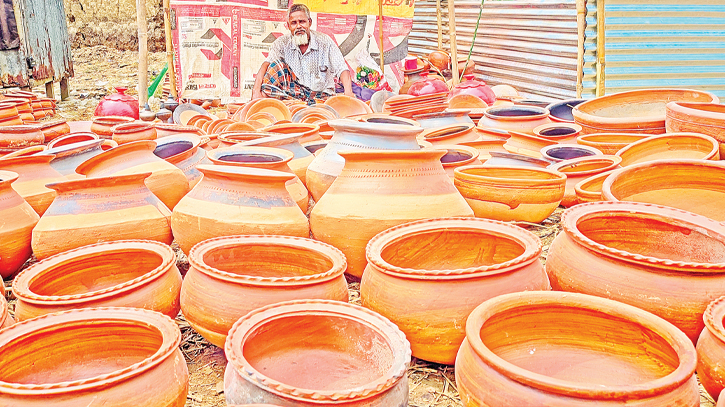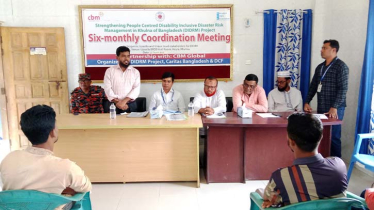
Trades like pottery, toy making, and other clay items are gradually diminishing, with artisans now primarily focusing on crafting curd pots to sustain their businesses. Photo: Messenger
The traditional artisans of handmade clay products in Gaibandha are facing challenges due to the pervasive influence of plastic products, impacting their livelihoods significantly.
Trades like pottery, toy making, and other clay items are gradually diminishing, with artisans now primarily focusing on crafting curd pots to sustain their businesses.
In the past, pottery flourished across the country, with bustling activity in Kumarbari and Palpara involving the production of diverse earthenware like pots, pans, jugs, glasses, and various toys. However, the dominance of plastic materials has led to a decline in the production and demand for clay products.
A visit to Palpara in Harinath Pur Union of Palashbari Upazila reveals a stark contrast from the once thriving pottery families. Formerly busy making earthenware throughout the day, these artisans now struggle to find work, reflecting the changing landscape of their traditional profession.
Historically, Palpara flourished as a haven for potters, its roots tracing back to settlers from across the border. Approximately 70 to 80 years ago, a group of potters migrated from India and settled in the area, witnessing a bustling business post-independence.
Yet, in recent years, the allure of clay has waned, overshadowed by the allure of plastic. Even once-popular items like curd pots now face dwindling demand, signaling a somber shift in consumer preferences.
However, over the past decade, the demand for clay pots and earthen goods has dwindled significantly, with the value declining due to the proliferation of plastic alternatives. Despite facing challenges such as rising material costs, these artisans persevere in upholding the legacies of their ancestors.
Dhiren Pal from Pal Para reminisces about the past when farmers frequented the area to acquire mats for their cows and rice storage, underscoring the shift in consumer preferences towards plastic goods. Similarly, Suman Pal, a clay product seller in Ramchandrapur Union, notes the diminishing value of clay items, attributing the decline to changing consumer habits and preferences.
Rabindra Chandra Roy, Assistant General Manager of Gaibandha BCIC, highlights the availability of low-interest loans for pottery promotion, emphasizing the need for artisans to engage with the support systems in place to sustain and revitalize the pottery industry in the region.
In the face of adversity, hope flickers in the form of initiatives like low-interest loans offered by entities like the Gaibandha BCIC. While financial aid may provide a temporary respite, the long-term viability of the pottery industry hinges on a broader societal shift. Recognition of the cultural significance of clay craftsmanship, coupled with consumer awareness campaigns, could reignite interest in traditional art forms.
The plight of Gaibandha's clay artisans serves as a poignant reminder of the delicate balance between tradition and progress. As plastic permeates every aspect of modern life, it threatens to extinguish the flames of creativity and heritage. Yet, amidst the encroaching shadows, the resilience of these artisans shines as a beacon of hope, a testament to the enduring spirit of human craftsmanship. Only through collective effort and unwavering support can we ensure that the age-old art of pottery continues to thrive for generations to come.
Messenger/Disha








